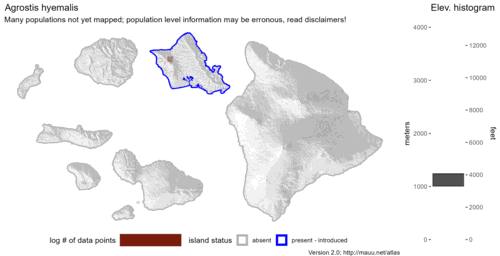Info
Subfamily: Pooideae
Genus etymology: Agrostis the ancient Greek name for herbacous plants in general, literallly "field / pasture". Its later use in plant names is reserved for grasses and there are many grass genera suffixed with Agrostis
Species etymology: hyemalis = "winter" [Latin] refering to the flowering period
Photosynthetic type: C3 (cool season)
Nativity: naturalized - accidental
First recorded in Hawaiʻi: 2005
Map

Inflorescence
 image credit: Nathan_Aaron
image credit: Nathan_AaronPlant
 image credit: Jody_Shugart
image credit: Jody_ShugartDescription
Plants perennials or facultative annuals; cespitose, not rhizomatous or stoloniferous. Culms 15-82 cm, erect, with (3)4-7 nodes. Leaves cauline and basal; sheaths smooth; ligules (0.7) 1.2-4 mm, dorsal surfaces scabrous, apices usually rounded to truncate, sometimes acute, lacerate-erose; blades 3-10 cm long, 1-2 mm wide, flat, becoming involute, or folded. Panicles (5)10-25(36) cm long, (3)4-24 cm wide, broadly ovate, often nearly as wide as long, diffuse, the whole panicle often detaching at the base at maturity, forming a tumbleweed, bases often enclosed by the upper sheaths, lowest node with (3)5-11 branches; branches scabrous, capillary, flexible, wide-spreading, branching in the distal 1/4, spikelets strongly clustered at the branch tips, lower branches 5-15 cm; pedicels 0.1-2.5(3.5) mm. Spikelets ovate to narrowly ovate, greenish or purplish. Glumes subequal, 1-2 mm, 1-veined, keeled, keels scabrous, sometimes the body also scabrous towards the apices, acute to acuminate; callus hairs to 0.2 mm, sparse; lemmas 0.8-1.2 mm, scabridulous, translucent to opaque, 5-veined, veins obscure or prominent distally, apices usually obtuse, sometimes acute, entire, unawned; paleas absent, or to 0.2 mm and thin; anthers 3, 0.2-0.5 mm. Caryopses 0.7-1 mm. 2n = 28.
(Description source: Barkworth, M.E., Capels, K.M. & Long, S. (eds.) 1993. Flora of North America, north of Mexico. Volume 24. Magnoliophyta: Commelinidae (in part): Poaceae, Part 1. Oxford University Press, New York. 911 pp. http://floranorthamerica.org/Agrostis_hyemalis )